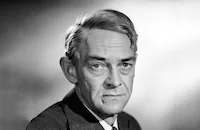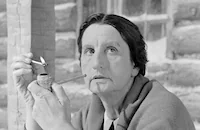Westward the Women

Brief Synopsis
Cast & Crew
William A. Wellman
Beverly Dennis
Renata Vanni
John Mcintire
Julie Bishop
Hope Emerson
Film Details
Technical Specs

Synopsis
By 1851, Roy E. Whitman has established a growing ranching community in his California valley. The one thing missing is women for the men to marry, which would enable them to set down roots in the valley. Whitman hires scout Buck Wyatt to travel with him to Chicago, where he hopes to recruit enough women to provide wives for one hundred men. Buck thoroughly disapproves of the idea, believing that the journey across the country is too hard for women, but when Whitman offers him double his usual salary, he reluctantly agrees. The 140 women whom Whitman recruits are a varied group, including Patience Hawley, the aging widow of a New England sea captain; farm girl Maggie O'Malley, an expert with a gun; Rose Meyers, who is pregnant with an illegitimate child; Mrs. Maroni, an Italian widow traveling with her nine-year-old son Tony; and French-born Fifi Danon and Laurie Smith, two former prostitutes looking for a new life. Buck also hires fifteen men to help him get the women to California, warning both the men and the women against fraternization. After a quick lesson in mule driving, the journey begins. Buck immediately has to send one of the men away when he behaves familiarly with one of the women, and promises that he will kill the next man he catches breaking the rules. The journey is every bit as difficult as Buck had predicted. Indians circle the wagon train and, although they do not attack, they announce their intention to return later. When Laurie is raped by a man who believes that her former profession allows him to treat her any way he wants, Buck carries through with his promise and kills the man. That night, many of the men leave, taking some of the women with them. Jim Stacey, who has fallen in love with Rose, asks her to leave with him, but when she refuses to abandon the train, he stays with her. The next morning, Buck discovers the defections, but rather than turn back, he announces that he will make the women into men. The first step is to teach them how to use a gun. During the practice Tony is accidentally shot and killed. Mrs. Moroni becomes temporarily insane, and Buck must drag her off her son's grave and put her in Patience's care. The women negotiate a difficult pass, clearing the rocks and trees before lowering the wagons with ropes, and one woman is killed in the process. Later, the mules stampede when Danon fires a gun at a rabbit. In reaction to Buck's anger at her, Danon rides away from the train, and he chases after her. After an argument, they admit they love each other. When they return to the train, they find it under attack from Indians. After the attack, a roll call of the casualties reveals the deaths of Whitman, Jim and several of the women. Buck and Ito, the Japanese cook, are the only men left. Later, Laurie is killed when her wagon is washed away during a thunderstorm. The last big obstacle facing the women is the desert. Rose goes into labor during the crossing, and when a wheel falls off the wagon in which Patience is caring for her, the women hold it up until after the birth of her baby boy. Finally, the train reaches its destination, but the women refuse to meet their future husbands until they have had time to clean up. When they are ready they drive into town to meet the waiting men. Buck is now the admiring champion of these plucky women and warns the men to be good to them. As the women choose their husbands, Danon stops Buck before he can leave, and they join the line of couples waiting to be married.

Director

William A. Wellman
Cast
Beverly Dennis
Renata Vanni

John Mcintire

Julie Bishop

Hope Emerson

Marilyn Erskine
Lenore Lonergan
Henry Nakamura

Denise Darcel

Robert Taylor
Guido Martufi
Bruce Cowling
Patrick Conway
Chubby Johnson
Mary Alan Hokanson
Raymond Bond
Terry Wilson
Michael Dugan
Edith Mills
John Cason
Mikel Conrad
Lou Nova

Frankie Darro
Z. Yaconelli
Ted Adams
Gene Roth
George Chandler
Earl Hodgins
Stanford Jolley
John War Eagle
Bert Lebaron
Elmer Napier
Ann Roberts
Lucille House
Shirley Lucas
Pat Paul
Donna Hall
Opal Erne
Norma Santillo
Norma Young
Jody Smith

Mary Murphy
Sharon Lucas
Mary Casiday
Cornelia Flores
Stevie Myers
Alice Wills
Edith Happy
Karen Hale
Claire Andre
Maxine Garrett
Marilyn Lindsey
Marlyn Gladstone
Fiona O'shiel
Alice Markham
Polly Burson
Evelyn Finley
Kathleen O'malley
Doris Lee Cole
Henry Wills
Ed Juaregui
Archie Butler
Bill Cartledge
Carl Pitti
Pat Ford
Frank Mcgrath
Don House
Ray Thomas
Clem Fuller
Clint Sharp
Gene Coogan
Claire Carleton
Dorothy Granger
Mil Patrick
Joan Valerie
Tom Greenway
Tom Monroe
Tennesse Jim
Crew
Jeff Alexander
Al Alt
Reggie Callow
Frank Capra
Daniel B. Cathcart
Cedric Gibbons
Arvid Griffen
Ralph S. Hurst
Johnny Indrisano
Conrad Kahn
Rudolph G. Kopp
Jim Louck
Tommy Mccoig
William Mellor
James E. Newcom
Walter Plunkett
Ruby Rosenberg
Henry Russell
Dore Schary
Charles Schnee
Douglas Shearer
Jerry Thorpe
Edwin B. Willis

Videos
Movie Clip




Trailer
Film Details
Technical Specs

Articles
Westward the Women
Taylor had started his career playing photogenic romantic foils to stars like Greta Garbo, but by this time he had developed into a fine actor, and Westward the Women features one of his most striking and hard-bitten performances. Wellman loved working with him. "I was crazy about Bob Taylor," said the director. "I think he's one of the finest men I've ever known...He was probably handsomest of them all. And he did everything I asked him to."
Though usually remembered for action pictures like Wings, Public Enemy, The Story of G.I. Joe and Battleground, Wellman directed a wide variety of genres and many films with strong women at their centers (including five with Barbara Stanwyck). Before production started on Westward the Women, Wellman gathered all the women together to tell them in no uncertain terms what they were getting themselves into - much like Taylor does in the movie. Wellman biographer Frank Thompson later wrote, "he told them that there would be no room for prima donnas, for the 11-week schedule in the Utah Mountains and California desert would prove to be long, dirty and tiring. He offered everyone a last chance to back out. The women began a three-week period of basic training which involved calisthenics, rope skipping, softball, bullwhip cracking, horseback riding, mule team handling, firing frontier firearms, blacksmithing, and assembling (and disassembling) covered wagons."
While the "feminizing" of a male-oriented genre like the western was nothing new (there existed other women's westerns as well as women's gangster films, prison films, pirate films and combat films), Westward the Women went a step deeper than most. As film historian Jeanine Basinger has written, it is "one of the few films to present positive, overt sisterhood. It is almost a casebook of traditional attitudes toward women that will be refuted by the visual presentation." In other words, while the female characters may be spoken to or treated derisively, the audience is made to see them positively, even heroically. For instance, there are images of the women growing comfortable facing tough tasks, working together to fix a wagon and fight off Indians. Wellman often shoots the women from below, framing them prominently against the sky. His admiration for these characters and their bravery could not be clearer. As Basinger puts it, "dramatic images of individual women against an open and stark landscape are rare in American films, and they are memorable."
Basinger also observes provocatively that "when a woman's version of a male genre is created, things that are associated with the woman's world (primarily issues of love and romance, marriage, sex, rape, and childbirth) must be reconciled in some manner with the male movie." By the end of this film, the women "have been told they can't cope, can't shoot, can't rope, can't ride, can't fight, and can't endure, and they have proved this to be wrong. These 'masculine' things are now absorbed into them."
A final note: To stress the audience's feeling of the harshness and heat of the terrain, Wellman had his cinematographer, William Mellor, use filters as sparingly as possible. This gives the film an intentionally stark, sunbaked look.
Producer: Dore Schary
Director: William A. Wellman
Screenplay: Charles Schnee (based on a story by Frank Capra)
Cinematography: William C. Mellor
Film Editing: James E. Newcom
Music: Jeff Alexander, Henry Russell
Art Direction: Daniel B. Cathcart, Cedric Gibbons
Costume Design: Walter Plunkett
Cast: Robert Taylor (Buck Wyatt), Denise Darcel (Fifi Danon), Hope Emerson (Patience Hawley), John McIntire (Roy E. Whitman), Julie Bishop (Laurie Smith), Lenore Lonergan (Maggie O'Malley), Marilyn Erskine (Jean Johnson), Beverly Dennis (Rose Meyers), Henry Nakamura (Ito).
C-117m. Closed captioning.
by Jeremy Arnold

Westward the Women
Quotes
Trivia
Notes
The film's pre-release title was Pioneer Women. The opening credits list Robert Taylor and Denise Darcel first, with several other cast members listed after them. The end credits show various members of the cast, with their character names, and end with Robert Taylor, followed by the words "and the women." According to International Photographer, the film was shot on location in Suprise Valley, Paria Canyon and Johnson Creek, UT, with the location camp in Kanab, UT. Hollywood Reporter news items noted that additional location shooting took place in Mojave and Death Valley, CA. Time noted that M-G-M made a short about the production's location shoot.
International Photographer also noted that actor Henry Nakamura's role was written especially for him after director William Wellman and producer Dore Schary were impressed by his performance as the lovable "Tommy" character in the 1951 M-G-M film Go for Broke!. According to various Hollywood Reporter news items, Sid Melton was cast, but he was not in the released film and John Lupton was on location with the production when he was called back to report to the army. It is unclear whether Lupton had filmed any scenes prior to leaving the production, but he is not in the released film. Another Hollywood Reporter news item included Lloyd Hanlon in the cast, but his appearance in the released film has not been confirmed. Westward the Women marked the motion picture debut of Broadway actress Marilyn Erskine. M-G-M News noted that Wellman cast Navajos, Utes and Piutes as Indians in the film. Contemporary reviews and news items variously stated that 100, 140, 200 and 400 women took part in the film, although the film itself refers to 140 women. According to his autobiography, Frank Capra had planned to direct the film himself and cast Gary Cooper in the lead, but later sold his story to his neighbor, Wellman.















